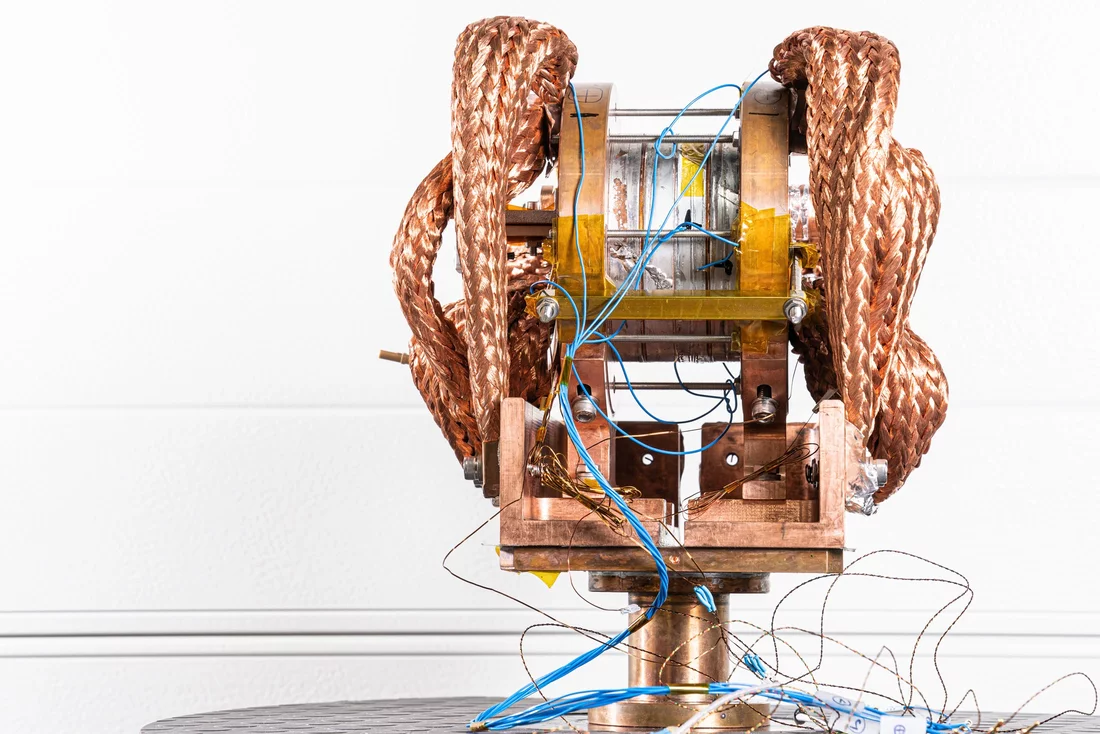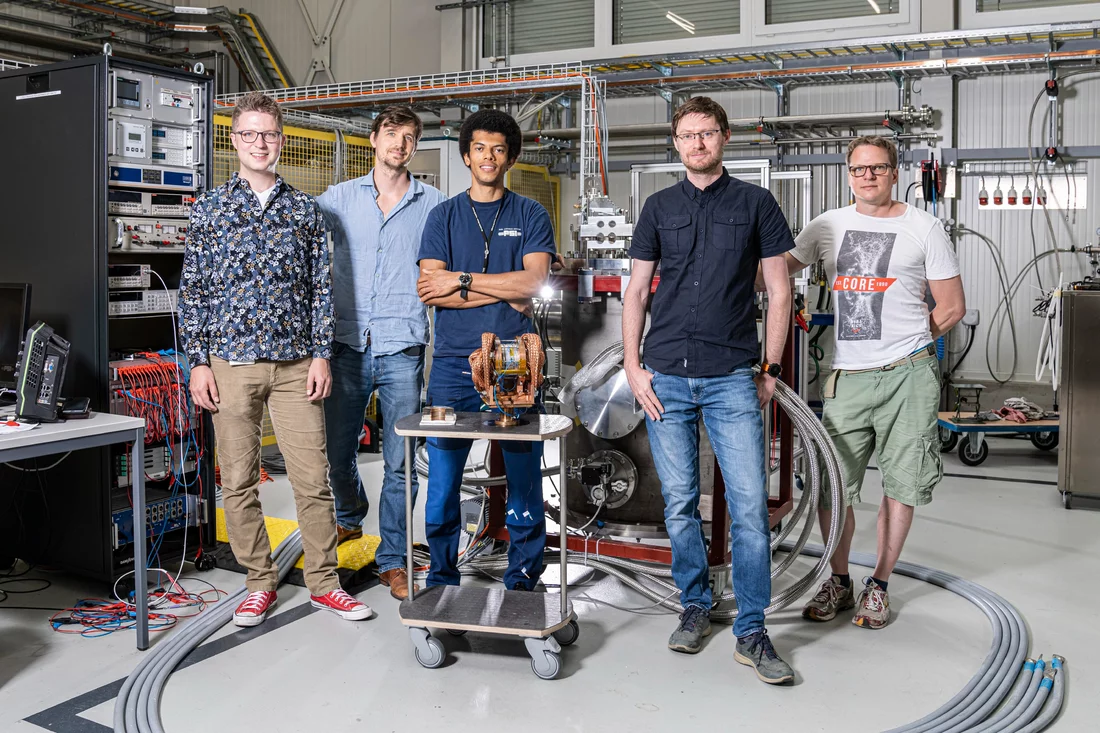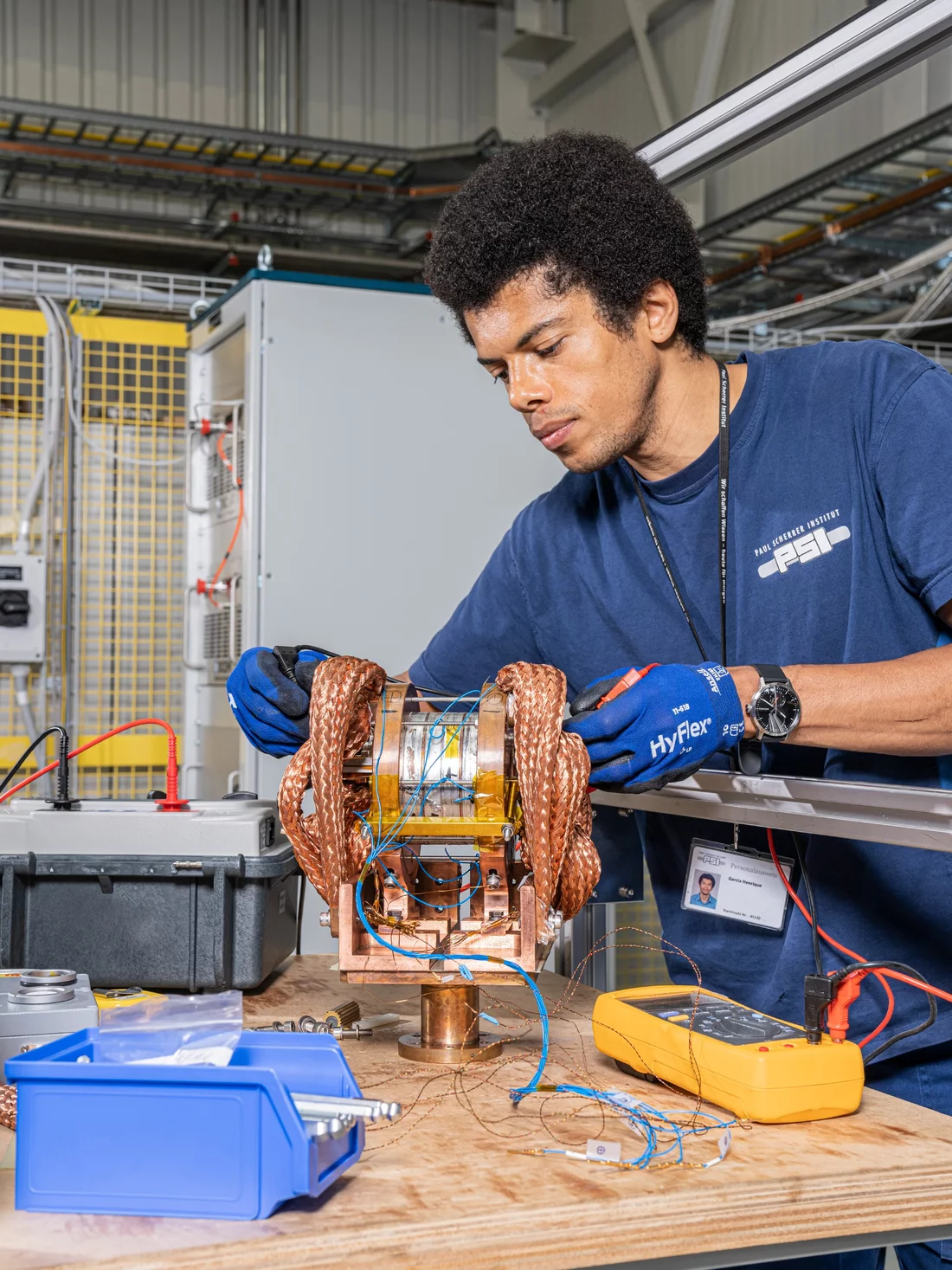Probing the very smallest building blocks of matter requires big experiments, and powerful technology. That is why physicists used innovative high temperature superconducting technology to build an 18 Tesla electromagnet – more than twice as strong as the magnets found in the Large Hadron Collider at CERN. In particle accelerators, stronger magnets mean faster particles, higher energy smashes - and thus new physics.
One day, the Large Hadron Collider (LHC) will come to an end. Its successor is already in the planning: the Future Circular Collider (FCC). Bigger and better, to delve even deeper into the secrets of the universe the FCC will need some serious technology – in particular, magnets. To this end, researchers at PSI have been developing extraordinarily powerful magnets that will eventually steer high energy particles in the FCC. The development of these magnets at PSI, in what is known as the MagDev project, is part of the CHART (Swiss Accelerator Research and Technology) framework, a collaboration to advance technological capabilities in Switzerland needed for FCC. Now, the MagDev team, together with the PSI Magnets Section, have made an electromagnet using innovative high temperature superconducting technology that has reached the lofty heights of 18.2 Tesla.
Currently, 1232 dipole electromagnets, each over 15 m long, guide particles round the ring of the LHC. Made of so-called low temperature superconductors (LTS), which operate at temperatures close to absolute zero, these magnets achieve fields in the region of 8 Tesla. The FCC will require magnets that comfortably reach 16 Tesla or more. A world-record with state of the art LTS technology using niobium tin, a brittle low-temperature superconductor, reached 14.5 Tesla. However, pushing the upper limits of its magnetic capabilities, today’s technology lacks necessary robustness. To meet the magnet demands of the FCC - and other future high energy particle accelerators - a technological leap forwards is needed.
Ultra-high field magnets of the future
High temperature superconducting (HTS) magnets, promising much higher fields or higher operating temperatures in a more compact design, could be the key. Yet, the technology is in its infancy. To develop HTS magnet technology at PSI, the MagDev team brought in a cutting-edge technology from British company, Tokamak Energy Ltd. Designed for applications in fusion energy, the coil of these solenoid magnets is made from the HTS, rare earth – barium – copper oxide, which superconducts at temperatures up to a balmy 77 Kelvin.
Through a collaboration and licensing agreement, the MagDev team could learn how to build, and adapt to their needs the company’s ‘no insulation’ coil technology – and with this achieve ultra-high fields with impressive robustness in a magnet that would fit inside a bike basket. Measured using a specially designed testing cryostat, the magnet achieved a whopping 18.2 Tesla when cooled to 12 Kelvin. “Stability to sudden thermal events is a headache for most magnets, but with this type of magnets, these problems disappear,” says Bernhard Auchmann, who leads the MagDev project. “We chose to partner with Tokamak Energy as they had developed and demonstrated their no-insulation coil technology in a very short time. The close exchange with them enabled us to get to where we wanted to be in just over a year.”
A deeper insight into the Higgs boson
The researchers are aiming to use this technology to build, in the next 6 months, a magnet that will surround the target at the FCC that is used to produce positrons. “Positrons will fly out of this target in many directions and the stronger the magnetic field, the more of them you can bundle down and capture. So, more field means increasing the positron output,” explains Auchmann.
This magnet will be tested at the X-ray free electron laser SwissFEL, where a project is underway to build a positron source as a proof of concept for the FCC. The temporary installation, planned to run between 2024 and 2025, will use the electron beam at the beginning of the SwissFEL and shoot it onto a target to produce positrons.
In the FCC, planned to take over from the LHC in approximately 2045, accelerated positrons will then be brought into collisions with electrons, producing Higgs bosons. “With the LHC you could produce enough Higgs particles to say that they existed. With the FCC you will produce thousands of Higgs particles per day, which will mean that we are really able to study the particle and search for traces of physics beyond the Standard Model,” he continues.
Synergies with PSI research
Yet the applications of this technology go well beyond the FCC project at CERN: great synergies exist with research at PSI. Many of the experiments at PSI’s varied facilities – with their diverse applications – depend on a strong magnetic field. The higher the field, typically the more exciting the physics. “We’ve already had first contact with researchers from various areas of PSI who are interesting in using this technology,” explains Auchmann. “Perhaps at the moment in a very compact setup they have magnets that achieve 0.8 Tesla. With the HTS magnets, we may be able to give them 6 Tesla, and that would be a different world. So it’s really an enabling technology that can increase physics reach in experimental setups.”
At the Swiss Light Source SLS, powerful, so-called ‘superbend’, magnets are used to deliver more intense synchrotron light at a shorter wavelength to certain beamlines, such as the TOMCAT beamline, for X-ray tomography. With the planned upgrade, SLS 2.0, the two existing superbend magnets will be replaced by higher field magnets based on low temperature superconducting technology. The MagDev project would like to use their expertise with HTS magnets to produce even stronger superbend magnets for specific applications, or superbend magnets of equivalent strength to their low-temperature counterparts that can operate at a considerably higher and therefore more economical temperature.
Proton therapy gantry magnets of the future
Ultimately, this first foray into HTS technology is just the beginning for the MagDev team. “We’re getting into HTS magnets because of their huge potential for so many different applications,” says Auchmann. But this first requires further research and development. The ‘no insulation’ coil technology of Tokamak Energy, designed for fusion energy applications, rapidly provides a highly stable field, but at a constant field strength. The ability to ramp the magnets – and thus adjust the field strength during operation to the desired energy – would open the door to many broader applications. Thus, the MagDev team are aiming to investigate different coil technologies using HTSs with advanced insulation that will enable the ramping of magnets and building of large magnet systems. “Eventually, we believe this will go into medical applications, such as future gantry magnets for proton therapy.” Of the benefits of this technology, Auchmann is convinced.
Behind these technological developments runs the same motivator. Fast forward half a century and the second phase of the FCC, a proton-proton collider, is projected to succeed the positron-electron FCC. This will require a daunting 6000-odd 15-m long ramping magnets, each providing over 16 Tesla. “By the time that series manufacturing of the magnets starts, we expect that the price of HTS conductor will have reduced considerably. We need to be ready with the magnet technology to reap the benefits,” says Auchmann.
As seen within the bounds of PSI – consider how the HIPA proton accelerator, developed for particle physics research, lead to breakthroughs in proton therapy or the X-ray detector advances at the SLS now used in medical imaging - technology developed to push the boundaries of our knowledge catalyses innovation with very real societal impact. With the proton-proton FCC still a distant dream, it may be that the societal impacts of HTS magnet technology are realised before the end goal.
Text: Paul Scherrer Institute / Miriam Arrell
Contact
Dr. Bernhard Auchmann,
Paul Scherrer Institute,
Forschungsstrasse 111,
5232 Villigen PSI,
Switzerland
Telephone: +41 56 310 30 26
Email: bernhard.auchmann@psi.ch
Further Information
CHART-MagDev | GFA | Paul Scherrer Institut (PSI)
Home - CHART (Swiss Accelerator Research and Technology) - CHART
Funding
The work of CHART MagDev is supported by PSI, the Swiss State Secretariat for Education, Research and Innovation SERI, the ETH Board, and the CERN HFM project.
Copyright
PSI provides image and/or video material free of charge for media coverage of the content of the above text. Use of this material for other purposes is not permitted. This also includes the transfer of the image and video material into databases as well as sale by third parties.




